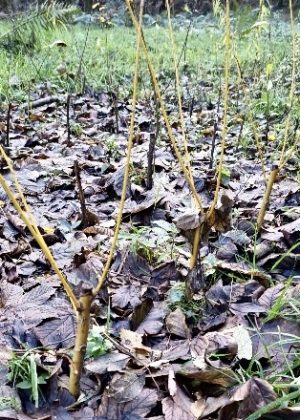Growing Osier for Basketry.

Along with my wife Marie, we purchased a 3 ½ acre semi ancient woodland in South Wales from woodlands.co.uk in April 2020. The site has a gentle slope from a country lane down to the river Rhymney, we have 2 springs, a stream, a wide variety of broadleaf trees, shrubs and a small amount of pine. Much of the site had been neglected for many years and so with help and advice from others and a great deal of hard graft by Marie and I we are bringing the site back to a sustainable future.
It is a delightful place to be, family and friends all enjoy spending time there and I don’t think I have ever been to the woodland without seeing or discovering something new. We made a decision early on that an open area next to the river would be a good place to grow willow but we also wanted to utilise some willow for basketry. We had experience of neither. The river can breach its banks and wash over the area occasionally although this is generally very short lived.
Although the rest of the woodland will be maintained with native species, the willow area is an experiment and we decided to plant a variety of species for basketry, some of these are non-native.
We read a great deal about varieties, planting and harvesting and decided on the varieties we wanted to grow. A very useful book titled Willow by Jenny Crisp gave us a lot of helpful information and ideas. We based our choices around colour, they range from golden brown to yellow, red, green and black. Each variety will grow to different lengths in the same year once established, some as much as 17 feet.
We searched on the internet for suppliers of cuttings for planting and were very fortunate to find a supplier, https://hattonwillow.co.uk/ based only a few miles away in Caerphilly. Hatton Willow is run by a Sarah Hatton*, she has a plantation with 1000’s of willows and supplies cuttings for planting and basketry, runs basketry classes and makes various commissions as well as the odd appearance on 'The Repair Shop' and 'Country File'.
The plants are supplied as rootless cuttings, about 12 inches long in the winter and need to be planted between November and March.  You are advised to lay weed suppressant material and to push the cuttings through this into the ground. If like us you are growing for harvesting, each row is planted 60cm apart and the cuttings 30cm to 60cm apart depending on the variety. This close planting ensures that the sticks grow straight and long and can be easily harvested the following year.
You are advised to lay weed suppressant material and to push the cuttings through this into the ground. If like us you are growing for harvesting, each row is planted 60cm apart and the cuttings 30cm to 60cm apart depending on the variety. This close planting ensures that the sticks grow straight and long and can be easily harvested the following year.
We ordered 100 cuttings, 10 of each variety so the area taken up is relatively small. 100 plants won’t give us enough willow to go into production but supplemented with some bought sticks will give enough eventually to make some items for our own use.
Once the leaves have dropped, we will cut this years growth back, some of which will become cuttings for new plants and over the years as the plants produce more sticks, we will have more to work with.
The above image shows the growth on a few of this year’s saplings. Not as vigorous as we had hoped but next year they may establish better. With our willows in the ground, we booked a course at Hatton Willow and used some of the £300 funding provided by woodlands.co.uk as part of our purchase to fund the course. The session taught us how to make a trug, the courses just span a day, all materials and tools are supplied and at the end of the day you come away having
- learnt enough of a new skill to repeat the work,
- an understanding of the material and
- expanded your knowledge and
- created your own hand-made basket.

What Next for us? The options are endless, willow hurdles for our allotment, Christmas wreaths, nesters for birds, green willow sculpture, who knows, we’ll keep you posted.
Marie and Marcus Beard.
* Sarah runs her courses at the Nantgarw China Works, a venue worth a visit in it’s own right.
Comments are closed for this post.
Discussion
Good on you! I have a small wettish area of land which I planted up with 500 ‘sticks’ about 6 years ago. I had glyphosated the grassed area but not enough for a full and sustained kill. It took about 3 years to fully establish the willow and there was a high percentage of failures. The wet spring of this year saw the plants really take off and they are now mostly above 15 feet. It had not occurred to me that grass was so competitive, something I was to learn also from planting 200 hybrid poplar. So anyone reading this benefit from my mistake and ENSURE YOU HAVE ADEQUATE WEED/GRASS SUPPRESSION in place. Poplar and willow are very susceptible to glyphosate treatment and so using it as a control is nigh on impossible in the early years.

Thanks so much for this lovely blog. I’m so glad you enjoyed making the trug, it was a great day sat in the sunshine in the garden at Nantgarw. Also great that your willow cuttings are growing well. Cut them down this winter and they’ll grow back even stronger.
Best wishes
Sarah
Sarah Hatton
3 December, 2021